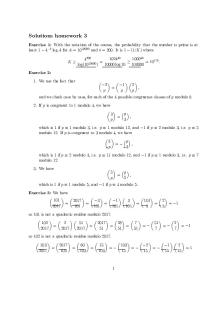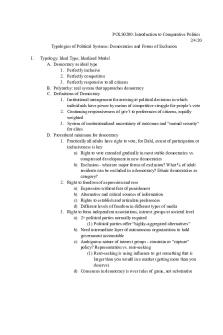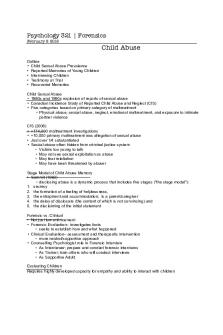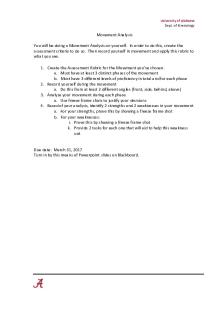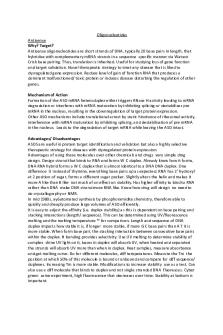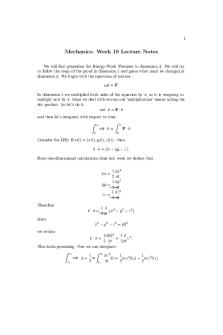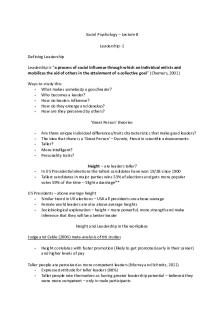Surveys - Taught by Koen Slootmaeckers and Eric Harrison PDF

| Title | Surveys - Taught by Koen Slootmaeckers and Eric Harrison |
|---|---|
| Author | Abigail Wroblewski |
| Course | Producing Social Data |
| Institution | City University London |
| Pages | 11 |
| File Size | 274.4 KB |
| File Type | |
| Total Views | 116 |
Summary
Taught by Koen Slootmaeckers and Eric Harrison...
Description
Survey investigation where systematic measurements are made over a series of cases. Variables in resulting matrix are analysed to see if they reveal patterns. A survey is distinguished by particular, standardised approaches to data collection and analysis. Always a particular substance (structured reporting) Key feature is it should have more than one case and measure the same variables for each. Each case has one code only for each variable. Data could come from observations, responses to questionnaire, content analysis of media, coded in-depth interviews It is NOT an experiment - can’t control everything in the environment. Survey method involves systematic collection of the same variables in more than one case in a form that permits analysis of associations. It developed because the state needed, then wanted to know things about its citizens. Started with description (or estimation) - ‘who, what, how many, where’ and moved onto explanation for policy and problem solving - why, how, when. Based on clearer measurement now, systematic data collection and new techniques of analysis ‘survey logic’. Surveys have their origins in government (‘state’ in statistics) All bureaucracies need to collect data about their populations. This is more important under capitalism - population growth key to economic prosperity. Earliest social science was political arithmetic, a purely descriptive exercise Debates about population growth and decline continued; optimists vs pessimists. Crude methods used eg multiplying the number of houses paying window tac by avg family size. Campaigning to introduce a census; in the 19th century debate changed, population out of control death, disease Victorian variables •The condition of England: industrial poverty led to investigative journalism. •Data collection and description but not at all ‘systematic’ •Single observations disputed as atypical •Early Victorian period sees founding of Statistical societies – health and wellbeing of working classes
1800s •Founding documents of the London Statistical Society : ‘ the first and most essential rule of its conduct is to exclude all opinions’ (aliis exterendum) •Earliest use of standardised interview schedules, interviewer training, precodes and percentages •1837 General register Office (births, deaths, crimes) •1841 and 1851 Censuses conducted •Statistical societies died out but social unrest in late 19th C revived investigation by private individuals (the ‘Chocolate sociologists’) •Survey research becomes aligned with policy research •Booth – The Life and Labour of the People of London (80% population coverage) allegedly triggered by an empirical claim (25% in dire poverty) •Sources of information sometimes the poor themselves, sometimes expert witnesses (economies of scale). Evidence from Mayhew disputed based on the ‘known untrustworthiness’ of the poor
•No concept of a ‘respondent’; no attention to question wording. Marx recruited volunteer sample and asked pointed open-ended questions about work •Rowntree investigated poverty in York: covered every wage-earning family, force of interviewers, new definition of poverty. Gradual progress begins here •Growth of standardisation of wording and definitions – defined calorific value of basic diet and cash needed to buy it – family budget diaries •Bowley – the Measurememt of Social Phenomena (1915) – standard definitions and units. Development of sampling theory: Gauss, Fisher •Application from quality control in industry Interwar years Growth in social research and social surveys but largely more of the same. Ministry of labour established a director of statistics to monitor its emerging welfare state •Approach of war led to expenditure surveys to plan supplies; cost of living index devised; surveys of housing conditions •Few methodological advances but more being done. Emphasis on ‘facts’ (cf Mass-Observation formed 1937, assesses moods and opinions) Changes after 1945 •First ‘total war’ – civilian population enveloped •Rationing of resources; fears for morale •Growth in government survey activity •Wartime Social Survey 1940 by Ministry of Information to gauge morale. Taken over by Gallup and made more factual but it survived as The Social Survey after the war and lasted into the 1970s •Advances in multi-stage sampling designs, sampling frames, questionnaire design and coding
Rise of a Consumer society/Surveys •Major steps forward in consumer research •Goods, services, cultural outputs, political products •Market research, readership surveys, audience reaction, political opinion polls •So-called ‘subjective domains’ •Social indicators pioneered; customer and citizen satisfaction surveys Polls •Growth of commercial polling organisations tied to newspapers (Daily Mail owned NOP) •Growth of Quota sampling – better VFM •Advances in technology and data processing •Less focus on question wording. Domination of survey research by statisticians •Sampling is King; non-sampling errors neglected until recently •Measurement error (response and non-response) now foregrounded – Total Survey Error approach Development of statistics = adding explanation to description Casual logic of survey analysis Theories must be expressed in casual terms. Looking at how things are and inferring why
Data collection must capture variation Technical ability to measure association between variables and allow the use of controls. A slow evolution… 1838 Journal of the Statistical Society of London ‘The Science of Statistics differs from Political Economy, because, although it has the same end in view, it does not discuss causes, nor reason upon probable effects; it seeks only to collect, arrange and compare…facts’ But interest grows in questions like ‘so what?’ and ‘why’? •Eg; need independent classification systems for death rates which avoid the things that might cause them. Durkheim classified suicides by causes – egoism, altruism, anomie, fatalism •This makes it impossible to separate predictor and outcome (circular reasoning) •20th C saw rise of statistical reasoning and ideas about association •Start of the use of tables and crosstabs (2x2) •Improved work on measurement – isolating individual variables (separating social class from IQ) Two components of data collection Mode/medium = vehicle for collecting data from survey sample members Questionnaire/message = script for a conversation between an interviewer and survey participant. Mode related issues: Sample frame Characteristics of target population - literacy, communication issues, availability, coverage Length of interview Data quality Methods of making contact and getting response - full inbox syndrome Respondent mode preferences Sensitivity of topic Is mode accessible to population Is questionnaire complex? Are questions appropriately designed? 88% of UK households have landline 16% of adults in mobile only household 83% of households claim they have internet access - comprehensive? 12% adults in GB ‘never been online’
Questionnaire Method for measuring and quantifying behaviours, opinions, attitudes. Sequence of questions (items). ‘Script for a conversation between interviewer and respondent’. Standardised tool. ● Key terms
What a survey aims to do Provide clear questionnaire script Communicate consistent meaning to respondents Obtain consistent answers from responses. Encourage and enable respondents to provide info in a format suitable for analysis. Obtain data that is valid, reliable and addresses the research Qs Ask Qs respondents can understand, are able to answer, are willing to answer, have specific and clear purpose, suitable for the mode. The role of cognition and communication A set of processes must take place for a respondent to give an answer - comprehend question, retrieve information, judgement, respond. This is a human process so things can go wrong: Respondent misunderstands Q Respondent unable to answer Q - doesn’t know Respondent unwilling to answer Q - sensitivity, doesn’t know what talking about Respondent adjusts response when answering. This can occur from context, ambiguity in terms or words, syntax/question’s length or complexity. To be a good consumer of data you need to think of where it came from and how produced. In order to be a good producer of data you need to think of where going and how consumed (design). Lesley Andres - Designing and Doing Survey Research Survey Formats ‘Survey research’ is an umbrella term under which a variety of different formats for gathering information resides. Although each format has its own distinct features, advantages and disadvantages, there are several commonalities among them. ● All solicit responses from individuals by asking Qs or for a response to a statement. ● Success of response rate depends on the prominence of the topic, the sampling strategy employed, the wording and sequence of questions, the timing of administration, the ease of participation for the respondent, and the degree to which the respondent trusts that the data will be reported anonymously. When deciding which to use think of these two perspectives; Mixed Modes (Dillman, 2000) more than 1 survey format is used with the goal of enhancing response rates - potential respondents may vary in personal preferences for survey formats. However types of survey responses may be incompatible to analyse with another. The goal is to embrace rather than stifle potentially contradictory findings collected by more than one method. Simply defined as taking ‘the best of qualitative and quantitative methods and combin[ing]
them’ (Bergman, 2008c), mixed methods research strives to transcend the barriers erected by the tenets of the qualitative and quantitative research camps. One or more survey research formats can be incorporated into, for example, ethnographic or experimental research designs with the goals of strengthening the explanatory power of the findings. Creative qualitative/quantitative configurations such as triangulation, concurrent embedded, explanatory, exploratory, and sequential embedded designs allow for the simultaneous merging of data or the use of one or more sources of data to extend the findings of research gathered by another method (Cresswell et al., 2008). Unimode construction aiming to avoid ‘the unsettling problem that people's answers to any particular question vary depending on the survey mode’ (Dillman, 2000: 6). When two or more formats are employed with the purpose of enhancing response rates and reducing non-consistent responses, the questions should be designed to provide the same mental stimulus. Attention to the consistency of response options, sequencing of questions, and instructions for completion will serve to reduce differences among different survey formats. Both perspectives could be adopted in a single project. For example, response rates to mail survey could be enhanced by telephone follow-ups constructed in a unimode fashion which are designed to elicit, as far as possible, the same responses as the mail survey. Then, in the spirit of mixed methods research, face-to-face interviews could be conducted to complement, complete, further develop, expand, corroborate/confirm, compensate for, and/or diversify the findings of the first phase of the study (Tashakkori and Teddlie, 2008). Self administered surveys A self-administered survey format requires that the individual complete the survey unaided by an interviewer. Respondents are required to read, either on paper or on a computer, a set of items to which they are invited to respond; hence, they are presented with a ‘visual channel of communication’ (Weisberg, 2005: 32). Advantages In most instances, respondents are able to complete the survey at their own leisure. As a result, responses may be more thoughtful and reflective. Sometimes, in order to respond to certain questions the respondent must consult records (e.g., university transcripts, sources of investment income). The ability to do so in a self-administered format will lead to greater accuracy, and hence better quality of information reported. Visual aids, such as charts, can be included in self-administered surveys. Because the respondent is not confronted with having to disclose information to an interviewer, a selfadministered survey mode is more conducive to studies on sensitive topics. Surveys that are read can employ longer lists of similar questions and can be constructed with more and/or more complex response categories. Disadvantages The respondent must be able to read the survey, follow the instructions, and respond as accurately as possible. Adaptation of survey instruments for certain groups (e.g., children, non-native language speakers, those with low literacy skills) may be possible. Otherwise, another format will be more appropriate. Because an interviewer is not involved in the data collection process, all components of the survey instrument must be clear, straightforward, and unambiguous. In addition, in a selfadministered format, there is no guarantee that the survey instrument has been completed by the intended respondent.
The extent to which respondents provide responses to open-ended questions depends on the relevance of the topic. Respondents to self-administered surveys are less likely to provide detailed answers to open-ended questions (Czaja and Blair, 2005: 39), leading to the conclusion that ‘open answers often do not produce useful data’ (Fowler, 2009: 72). However, others provide contradictory findings. For example, de Leeuw (1992) conducted an analysis of differences in responses to openended questions by mode (mail, face-to-face and telephone) and reported that differences were small and varied by type and position of the question. Group Administered Surveys When surveys are administered in a group format, the sample is almost always some type of intact convenience sample. Minimal costs, the ability to identify samples in advance, ease of administration, and the speed at which the surveys can be administered are the advantages of this format. Also, nonresponses are usually reduced to those who are absent at the time of administration. Although this format is primarily self-administered via pen and paper, the surveyor must at least deliver and collect the surveys and provide a minimum amount of explanation regarding their completion. Often, the surveyor invigilates the completion of the survey. It is possible that the surveyor, through the instructions or information about the purpose of the survey, could influence how the surveys are completed. The group setting, too, may create an atmosphere that affects how respondents give answers. Because of these potential disadvantages, the surveyor administering a group survey must pay attention to the instructions provided to the group, how questions by respondents will be answered, and whether and how those who are absent will be followed up. To ensure that surveys are completed fully and thoughtfully, sufficient time must be provided for their completion.
Mail Surveys Pen-and-paper surveys that are delivered to respondents by post or by courier. The respondent is instructed to return the surveys using the prepaid addressed envelope that should be provided. A mail survey has a certain charm in that it is a tangible entity. The accompanying cover letter can be personalized by addressing the intended respondent by name and can be signed personally by the surveyor. Cover letters can add an air of legitimacy and authority if they are produced on official stationary and are signed or co-signed by a person of authority. Mail questionnaires can be made attractive through interesting graphics, colour schemes, illustrations, and choice of font. Font sizes and style can be adjusted to suit the audience. Also, incentives of various forms (e.g., fridge magnets, sticky notes, pens, USB sticks) can be included in the survey package, along with research reports, newsletters, or other information of interest to the respondents. All the advantages of self-administered surveys are present in mail surveys. In addition, for the most part, mail surveys are not constrained by geographical boundaries; however, mail services to and from some countries may be problematic. Depending on the intended audience, it is possible for mail surveys to be longer and more complex than is advisable with other formats. In addition to the general disadvantages of self-administered surveys, mail surveys are rather expensive. Costs include the printing of questionnaires, mail envelopes, return envelopes, and reminder postcards; the price of postage; the cost of incentives and other enclosures; preparation of the mail-out packages; follow-up of undeliverables and non-respondents; and entry of data. Mail surveys require a sampling frame for which up-to-date mailing lists are available, as inaccurate mailing lists will drive up the costs of survey administration. Because the administration of mail
surveys requires administration and follow-up through the mail, when compared with other methods, the overall time to conduct such studies may be eight weeks or longer. After the initial mail-out, nonrespondents are sent reminder postcards. For undeliverable surveys, additional attempts to track down current mailing addresses may be attempted. After another waiting time period, a second survey package will be sent out, perhaps followed up with another reminder card or telephone call. Because the survey is self-administered and because individuals complete the surveys at their leisure, low response rates may result. Diaries A form of mail survey where respondents are asked to record, in considerable detail and usually over a period of time (e.g., a week or a month), certain behaviours. In addition, by employing panel designs – designs following the same people over time – and a survey structure designed specifically to record autobiographical memory, calendars and time diaries can be used to document the life courses of individuals. That is, information about educational and occupational attainment, marriage and family formation, and well-being and happiness can be captured over time through the use of diaries. Calendars are used to record the timing and duration of events, ‘states, conditions, and/or activities’ (Belli et al., 2009: 5) in the distant past, that is, months or years ago, and time diaries are employed to collect these types of information about the immediate past – the last day or week (Belli et al., 2009). Online Surveys Increased dramatically over the past several years. However, there are several drawbacks to online surveys, the most important being coverage issues. Although more and more individuals have access to computers and the internet, coverage and usage are not as predictable as opening one's mail or answering the telephone. Some individuals are connected constantly to the internet, while others may have access only at their workplaces. Others may check their email only sporadically. Internet use is correlated with age, educational status, income levels, and race/ethnicity, so online surveys are not likely to be appropriate when the frame population is comprised of, for example, senior citizens. Those living in geographically remote areas may have limited or no internet service. Also, although in theory the world of internet users is unlimited geographically, individuals in some countries or specific regions within countries may be difficult or impossible to reach through the internet. Because email addresses are required of the frame population, online surveys work best when nonsampling coverage error is known to be minimal. Individuals within intact organizations such as municipal offices, student bodies, and employees in large companies where internet use is part of everyday working life are good candidates for online surveys. Once it is deemed appropriate to use an online survey, there are many advantages beyond those of self-administered surveys. Online surveys are inexpensive to administer and, because they do not require the use of paper, they are environmentally sound. It is possible to collect data very quickly. Follow-up of non-respondents can be done easily over email. There are two types of online surveys; email surveys and web surveys. Email Surveys More primitive and basic form of on...
Similar Free PDFs
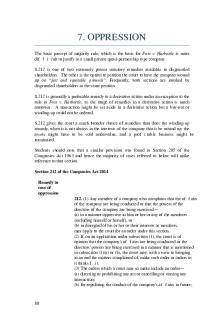
7. Oppression - Taught by John Quinn
- 10 Pages
Popular Institutions
- Tinajero National High School - Annex
- Politeknik Caltex Riau
- Yokohama City University
- SGT University
- University of Al-Qadisiyah
- Divine Word College of Vigan
- Techniek College Rotterdam
- Universidade de Santiago
- Universiti Teknologi MARA Cawangan Johor Kampus Pasir Gudang
- Poltekkes Kemenkes Yogyakarta
- Baguio City National High School
- Colegio san marcos
- preparatoria uno
- Centro de Bachillerato Tecnológico Industrial y de Servicios No. 107
- Dalian Maritime University
- Quang Trung Secondary School
- Colegio Tecnológico en Informática
- Corporación Regional de Educación Superior
- Grupo CEDVA
- Dar Al Uloom University
- Centro de Estudios Preuniversitarios de la Universidad Nacional de Ingeniería
- 上智大学
- Aakash International School, Nuna Majara
- San Felipe Neri Catholic School
- Kang Chiao International School - New Taipei City
- Misamis Occidental National High School
- Institución Educativa Escuela Normal Juan Ladrilleros
- Kolehiyo ng Pantukan
- Batanes State College
- Instituto Continental
- Sekolah Menengah Kejuruan Kesehatan Kaltara (Tarakan)
- Colegio de La Inmaculada Concepcion - Cebu


